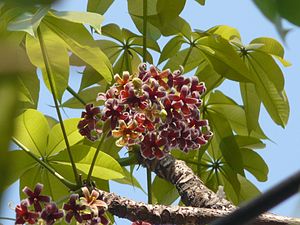Note: This is a project under development. The articles on this wiki are just being initiated and broadly incomplete. You can Help creating new pages.
Sterculia foetida - Vitkhadirah
Vitkhadirah, is a tall tree with digitate leaves and large woody pods. The seeds are edible and also used to make oil.
Contents
[hide]- 1 Uses
- 2 Parts Used
- 3 Chemical Composition
- 4 Common names
- 5 Properties
- 6 Habit
- 7 Identification
- 8 List of Ayurvedic medicine in which the herb is used
- 9 Where to get the saplings
- 10 Mode of Propagation
- 11 How to plant/cultivate
- 12 Commonly seen growing in areas
- 13 Photo Gallery
- 14 References
- 15 External Links
Uses
Parts Used
Chemical Composition
Common names
| Language | Common name |
|---|---|
| Kannada | baethaalada mara, basavana goota |
| Hindi | jangli-badam |
| Malayalam | pinari, pottakavalam |
| Tamil | atikanari, attirappidukkan, cutiram, cutiramaram |
| Telugu | gurapa, gurapubadam, gurrapubaadamu |
| Marathi | NA |
| Gujarathi | NA |
| Punjabi | NA |
| Kashmiri | NA |
| Sanskrit | putidaru, vitkhadirah |
| English | Java Olive |
Properties
Reference: Dravya - Substance, Rasa - Taste, Guna - Qualities, Veerya - Potency, Vipaka - Post-digesion effect, Karma - Pharmacological activity, Prabhava - Therepeutics.
Dravya
Rasa
Guna
Veerya
Vipaka
Karma
Prabhava
Habit
Identification
Leaf
| Kind | Shape | Feature |
|---|---|---|
| Palmately compound | alternate | clustered at the end of branchlets; stipules free, lateral, deciduous; rachis 8-24 cm long, slender, glabrous, swollen at base; leaflets 3-9; petiolule to 3 mm; lamina 5.5-14 x 2-5 cm, elliptic, elliptic-lanceolate or elliptic oblanceolate, base cuneate, apex acuminate, margin entire, glabrous, coriaceous; lateral nerves 10-24, parallel, close, slender, prominent, intercostae reticulate, slender, prominent. |
Flower
| Type | Size | Color and composition | Stamen | More information |
|---|---|---|---|---|
| Unisexual or Polygamous | axillary spiciform racemes | Orange red | 10 | in axillary or terminal racemes, foetid smell; calyx dull orange red, deeply 5-partite, glabrous out side, woolly inside; petals absent; male flowers: staminal column curved, hairy at base, bearing 10-15 anthers at its tip; female flowers: ovary 5, free, superior, downy, each with 20 ovules, gynophore stout; styles deflexed, hairy; staminodes subsessile in a ring beneath the carpels. |
Fruit
| Type | Size | Mass | Appearance | Seeds | More information |
|---|---|---|---|---|---|
| Aggregate of follicles | of 1-5, scarlet, boat shaped, 5-lobed, woody, glabrous; seeds black, numerous, ellipsoid, smooth, with a small yellow aril. | {{{5}}} | {{{6}}} |
Other features
List of Ayurvedic medicine in which the herb is used
Where to get the saplings
Mode of Propagation
How to plant/cultivate
Seeds need to be sown when fresh. [3]
Commonly seen growing in areas
Tropical area, Sub Tropical area.
Photo Gallery
References
External Links
Categories:
- Ayurvedic Herbs known to be helpful to treat Rheumatism
- Ayurvedic Herbs known to be helpful to treat Gonorrhoea
- Herbs with common name in Kannada
- Herbs with common name in Hindi
- Herbs with common name in Malayalam
- Herbs with common name in Tamil
- Herbs with common name in Telugu
- Herbs with common name in Sanskrit
- Herbs with common name in English
- Habit - Tree
- Index of Plants which can be propagated by Seeds
- Herbs that are commonly seen in the region of Tropical area
- Herbs that are commonly seen in the region of Sub Tropical area
- Herbs
- Plants of western ghats
- Tree
- Malvaceae





